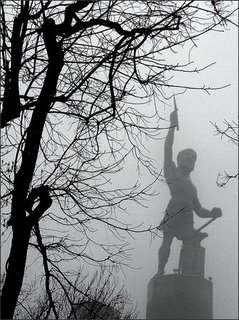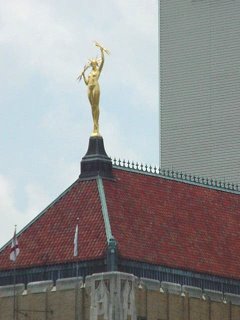I've said before that Birmingham Alabama is one of my favorite towns. I've been traveling her roads quite a bit lately, and I've begun to notice something; there a great many very notable statues and works of art here that have a high mythic or esoteric significance. You'll find these kinds of buildings and art in most towns, but in Birmingham, they REALLY jump out at you.
Birmingham is especially proud of a giant sculptre called Vulcan.
 And in fact, that's just what it is. An enormous likeness of the god Vulcan, also called Hephestus. Birmingham Alabama's Vulcan has the distinction of being the world's tallest iron sculpture. It was produced as a gift to the Magic City ( Birminghams' nickname, and another nod to the esoteric, which may be the subject of a future post)
And in fact, that's just what it is. An enormous likeness of the god Vulcan, also called Hephestus. Birmingham Alabama's Vulcan has the distinction of being the world's tallest iron sculpture. It was produced as a gift to the Magic City ( Birminghams' nickname, and another nod to the esoteric, which may be the subject of a future post)He was designed in 1924 by Italian sculptor Giuseppe Masetti. Vulcan is the Roman god of fire, and of the forge. The reason given for the statue's existence in Birmingham is that for many decades the city was a tremendous center of steel production. In legend, Vulcan wrought metal with his mighty hammer and anvil.
Of course I joke when I call Birmingham planet Vulcan. There's a lot more going on there than just this enormous Greek god. But this particular piece of work occupies a high place of honor in the city. It sits perched high above the valley on top of Red Mountain, much higher than any of the city's buildings. He's more or less Birmingham's official mascot, and he's very hard to miss.

Author and mythology researcher William Henry believes that most mythic figures and buildings in modern cities are built to convey a hidden, sometimes mystic message. He and I don't proceed from the same philosophical foundations- but I absolutely agree with him on this point. Read more about his assertions here. (He does a darn fine job of analyzing one of my other favorite cities, Nashville, TN )
Henry contends that figures like the massive Vulcan and other mythic personages are placed to send us a message...to convey thougts and ideas that go far beyond the mundane. What were the city fathers who so honored mighty Vulcan really trying to say?
It's a question I bear in mind as I ponder another mythic creature which also inhabits a high place of honor in the Birmingham skyline.
Occult researcher and commentator Freeman says U.S. cities feature large numbers of statues which represent female deities or goddess figures. She is often called the Great Goddess. And she comes in many forms. Wanna see one? Just go downtown to your local county or Federal courthouse. You'll see her with blindfold and scales. Look on top of the dome of your state capitol. Perhaps there she carries a scale and a sword. Go get a sandwich at Panera Bread, or check that silver dollar in your pocket. She is practically everywhere.
Freeman spells this out in a excerpt from one of his most recent web articles:
"If we consider the symbolism used by the brotherhood, the symbols most prevalent, go to the goddess. In America, we call her Columbia. In England she is known as Brittania, hence British Columbia. In the past she has been known as Semiramis, Ishtar, Anat, Asherah, Isis, Minerva, Aphrodite, Venus, et al. Now, let's look at the goddess symbolism. She is known as a triple goddess, trinities relate to her. In the Tarot the 3rd major arcana is the Empress. She is symbolized as a phoenix rising and is known as the eye goddess. As Venus, she is symbolized by a shell and a pentagram. Most of the goddess' have connections with the merfolk. Isis in the egyptian pantheon, is a symbol of Sirius, a recently re-discovered trinary star system..." Very heady stuff, yes. But the truth of these symbols is far more compelling than a passing glance will reveal. And far more important.
If we follow this idea, then Birmingham Alabama posseses a spectacular example of this goddess. The locals call her Lady Electra.
 She's the 23 foot tall, gold-plated statue which stands on tiptoe high atop the Alabama Power building downtown. There's nothing else quite like her in the state. The golden figure is four times taller than the average man. Clutching lightning bolts in each fist, the nude figure seems to be the very pinnacle of feminine power and pagan majesty. They call her Electra now, but an article on the statue tells us sculptor Edward Field Sanford Jr. originally entitled her the " Divinity of Light".
She's the 23 foot tall, gold-plated statue which stands on tiptoe high atop the Alabama Power building downtown. There's nothing else quite like her in the state. The golden figure is four times taller than the average man. Clutching lightning bolts in each fist, the nude figure seems to be the very pinnacle of feminine power and pagan majesty. They call her Electra now, but an article on the statue tells us sculptor Edward Field Sanford Jr. originally entitled her the " Divinity of Light".  Because of her brilliance to the eye and her high elevation above the city, she's really more compelling than even Vulcan. But what's even more important, is that she fits the continuing pattern visible in all of our cities of any size. She's literally a shining example of the female deity. The goddess held aloft. Whom do we adore? What do we really worship? To answer this question in a city like Birmingham, maybe all you gotta do is look up.
Because of her brilliance to the eye and her high elevation above the city, she's really more compelling than even Vulcan. But what's even more important, is that she fits the continuing pattern visible in all of our cities of any size. She's literally a shining example of the female deity. The goddess held aloft. Whom do we adore? What do we really worship? To answer this question in a city like Birmingham, maybe all you gotta do is look up.



